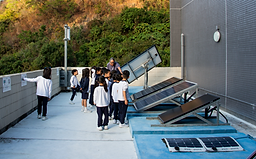
Climate Change
and School Grounds
Statement & Resources
ISGA FAZENDA SERRINHA - DE KALEI CLIMATE STATEMENT OCTOBER 2024
The International School Grounds Alliance strongly believes that as school grounds are at the heart of communities they play a significant part in responding to the impacts of climate change and ensuring climate justice* for children and young people. School grounds can provide quality spaces for communities to gather, to play, to learn, and to live in harmony with nature. They also link to local spaces, habitats and initiatives beyond their boundaries.


Download the climate statement
Chinese -simplified
Chinese -traditional
Swedish / Svenska
Dutch/ Nederlands
Portuguese / Português

German / Deutsch

French / Français.

Japanese / 日本語

Brazilian Portuguese
Spanish / Español

Photo: Cedric Ryckaert
The growing area, Klimaatspeelplaats Sint-Paulus, Kortrijk, Belgium

Photo: Cedric Ryckaert
Shade sales over a slide with sand, Klimaatspeelplaats Sint-Paulus, Kortrijk, Belgium
School grounds provide a key space for responding to climate change through:
-
Providing frequent contact with natural materials to improve physical and mental health
-
Learning about climate change by discovering its impacts through direct outdoor experience including play, learning, being and researching outdoors
-
Taking action by investigating issues, designing solutions and making positive changes to their grounds, leading to knowledge, skills and attitudes that will last a lifetime
-
ISGA believes that a whole school approach engaging pupils, staff and the local community results in culturally sensitive and contextually responsive solutions to climate change
-
We look at seven key climate themes with examples of who schools are addressing each impact around the world
-
Climate justice is the moral and ethical principle that seeks to address the disproportionate impact of climate change
Through a meaningful design of school grounds we can address the impacts of climate change in a range of ways, such as:

Creating shade at Don Bosco Vocational Trainings Centre, Phnom Penh, Cambodia

A variety of shade features at Escola La Maquinista, Barcelona (climate adaptive school grounds)
THERMAL COMFORT
Schools can mitigate effects of extreme heat and cold events:
-
Create shade and shelter for buildings and grounds through planting and structures
-
Create energy-efficient areas by using green roofs and facades
-
Make changes in design and build to improve air flow

Planting for pollinators. Ysgol Pentrefoelas, Wales, UK

Planting for the local climate. Green School, Bali, Indonesia
HEALTHY ECOSYSTEMS
Schools with healthy ecosystems help mitigate climate change:
-
Improve habitats to increase biodiversity
-
Ensure specific plant selection responds to local needs

Planting helps to maintain air quality,. Sherman Elementary School, San Francisco

Layers of planting combat pollution. Galilei Grundschule, Berlin
AIR QUALITY
School grounds can help improve air quality:
-
plant in and around school grounds to trap pollutants
-
provide different layers of planting

Stormwater management. Freie Waldorfschule, Berlin, Germany

Permeable surfacing, Brazil
WATER MANAGEMENT:
School grounds can help with water management:
-
use organic materials to retain moisture and improve soils
-
manage water through planting and design, water capture systems, increasing surface permeability and improved drainage

Mixed woodland edge and meadow, UK

CARBON MANAGEMENT:
School grounds can help to capture carbon:
-
plant mixed layers of vegetation with a range of life cycles
-
rejuvenate soils to improve carbon capture
Mature trees play their part in carbon capture in Chile

ISF HK Centre for Renewable Energy Education, Hong Kong

MATERIALS & MANAGEMENT:
School ground consumption choices can reduce impact on Earth's limited resources:
-
use sustainable materials from local sources and suppliers
-
refuse, reduce, reuse and recycle resource, and consider the end of life of materials and equipment used on site
Photo: Antje Schwabersberger
Using sustainable materials at Brodowin Primary School, Berlin, Germany

"Rocket" Composter. ISF HK Centre for Renewable Energy Education, Hong Kong

RESILIENT COMMUNITIES:
School grounds can build community resilience and hope:
-
grow vegetables using composted food waste and create food forests
-
open school grounds for community use
Community and school come together to grow crops, Sweden
Additional Climate Resources for School Grounds

A toolkit designed by Learning Landscapes for schools to consider their grounds in relation to climate change, climate action and education. The toolkit is free and contains information on running workshops and address learning and action on climate change.
The website offers resources to enhance climate literacy among children and youth, promoting a deeper understanding of climate change through education and fostering responsible environmental stewardship among young people
Videos
-
Smoke Sky - Children and the Climate Crisis -"It’s hard to imagine what the future will be like, if things today are the way they are," Alice adds. "And when nature is destroyed, the weather changes," Maria Isadora tells us. "The sky is all smoke," reveals Raphael, who lives in the Amazon region. Animated short "Smoke Sky - Children and the Climate Crisis" brings these and other statements by children living across Brazil; they tell us how they view and perceive the impact of climate crisis over their lives. The film is produced by Lunetas Portal, an Alana Institute initiative, and Toca de Barro Films.
-
Tari Haahtela: Biodiversity and health - a short presentation from the Climate and Adaptation symposium in Helsinki about biodiversity and health research in Finland
-
Aki Sinkkonen: Changing Living Environment and Immune Response – Correlations or Causalities? - a short presentation from the Climate and Adaptation symposium in Helsinki about biodiversity and health research in Finland
-
The Important Stuff | A message from children to COP28 leaders- What do children think and feel about the climate crisis? What would they say to world leaders who can make the changes needed to save the world they are leaving for them? The kids need action and global leaders need to hear them. The project "The Important Stuff" includes 6 films showcasing 25 children from 12 countries presenting their concerns, ideas, and solutions for real issues related to climate negotiations. It also calls attention to the necessity of a first decisive letter towards children’s rights

